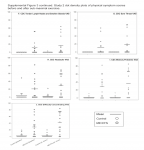http://www.tandfonline.com/doi/full/10.1080/21641846.2017.1321166
Symptom variability following acute exercise in myalgic encephalomyelitis/chronic fatigue syndrome: a perspective on measuring post-exertion malaise
Jacob B. Lindheimer a,b,c, Jacob D. Meyer c,d, Aaron J. Stegner b,c, Ryan J. Dougherty b,c, Stephanie M. Van Riper b,c, Morgan Shields c, Amanda Reisner c, Sanjay K. Shukla e, Alan R. Light f,g, Steven Yale h and Dane B. Cook a,b,c
aDepartment of Veterans Affairs, New Jersey Healthcare System, War Related Illness and Injury Study Center, East Orange, NJ, USA;
bDepartment of Veterans Affairs, William S. Middleton Memorial Hospital, Madison, WI, USA;
cDepartment of Kinesiology, University of Wisconsin-Madison, Madison, WI, USA;
dDepartment of Family Medicine and Community Health, University of Wisconsin-Madison, Madison, WI, USA; eMarshfield Clinic Research Foundation, Marshfield, WI, USA;
fDepartment of Anesthesiology, University of Utah, Salt Lake City, UT, USA;
gDepartment of Neurobiology and Anatomy, University of Utah, Salt Lake City, UT, USA;
hMarshfield Clinic, Marshfield, WI, USA
ABSTRACT
Background:
Consensus for an operational definition of postexertion malaise (PEM) and which symptoms best characterize PEM has not been established and may be due to variability within and between studies.
Purpose:
Determine the magnitude of the effect of maximal and submaximal physical exertion on multiple myalgic encephalomyelitis/chronic fatigue syndrome (ME/CFS) symptoms that are associated with PEM and explore variability among two studies in which mood, fatigue, and pain symptoms were measured before and after exercise.
Methods:
Symptoms were measured before, and 48 and 72 hours after exercise in study 1 (ME/CFS = 13; Controls = 11) and before and 24 hours after exercise in study 2 (ME/CFS = 15, Controls = 15).
Between-study variability was examined by comparing Hedges d effect sizes (95% CI) from studies 1 and 2. Within-patient group variability was examined via inspection of dot density plots.
Results:
In study 1, large increases in general fatigue (Δ = 1.05), reduced motivation (Δ = 0.93), feelings of fatigue (Δ = 0.90), feelings of confusion (Δ = 0.93), and total mood disturbance (Δ = 0.90) were found at 72 hours.
In study 2, a large increase in affective/sensory pain (Δ = 0.79) was found at 24 hours.
Dot density plots in both studies revealed substantial variability among people with ME/CFS relative to healthy control participants.
Conclusions:
PEM symptoms are variable among people with ME/ CFS and several gaps in the literature need to be addressed before guidelines for measuring PEM in the clinical or research setting can be established.
ARTICLE HISTORY
Received 9 December 2016
Accepted 11 April 2017

